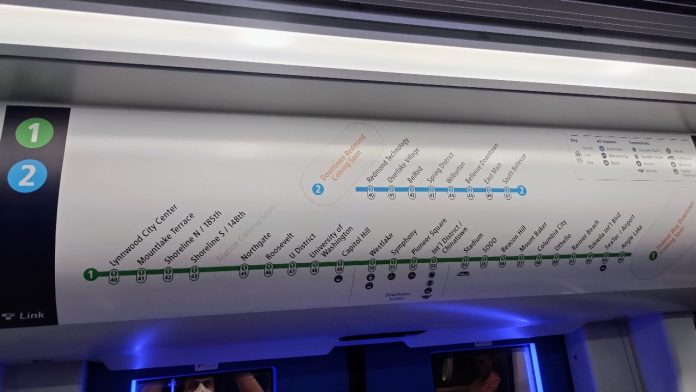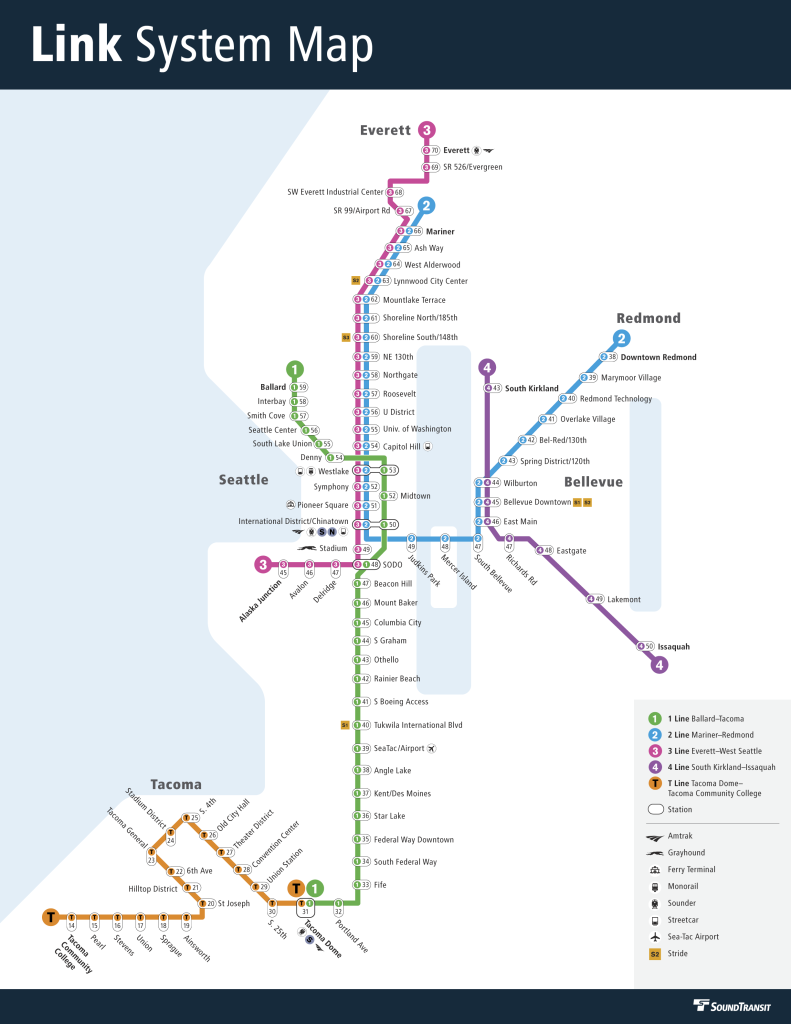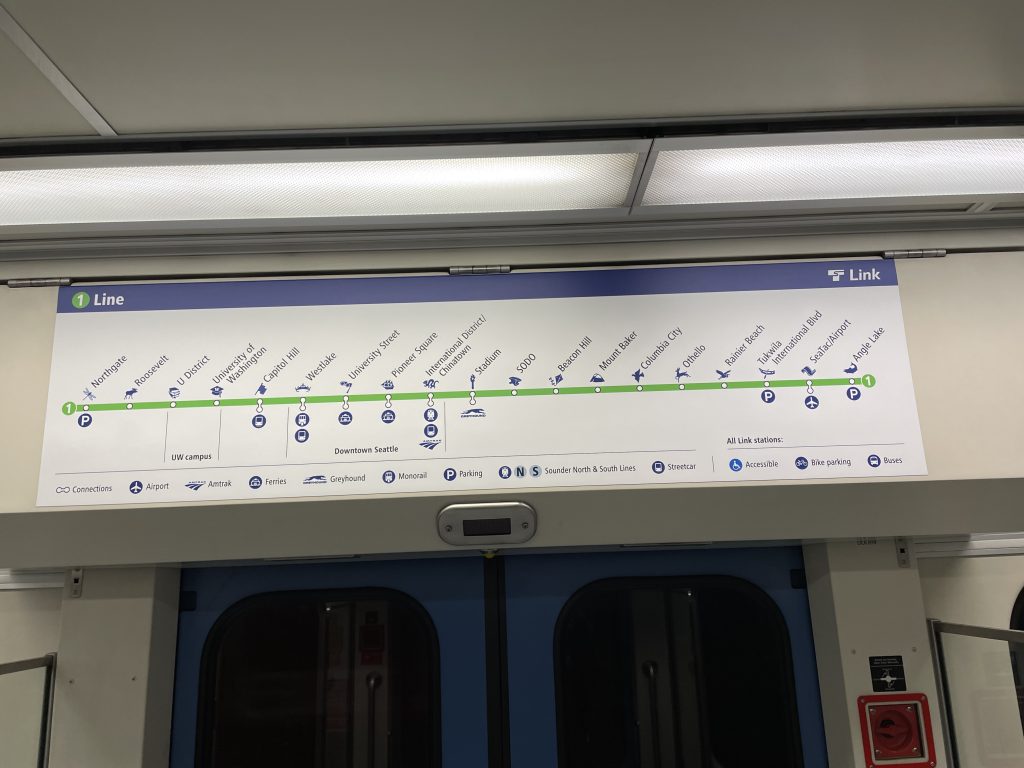
If you’ve been riding Link light rail recently, you may have noticed new progression diagrams onboard trains. The updated versions are meant to complement the upcoming 1 Line extension to Lynnwood, opening on August 30, and future-proof wayfinding materials for other upcoming extensions.
The main purpose of progression diagrams is to show stops along each Link line, helping riders identify their stop and where to make a transfer, if necessary. The latest series now features both the 1 and 2 Lines — instead of just the line that particular train is serving — plus station codes.
The new progression diagrams already show the Lynnwood Link Extension, with its four new stations. Consequently, the diagrams will be at odds with service realities for the next two months, showing the new stations while trains terminate at Northgate. Along with this, the diagrams tease other future extensions.
Because construction delays have pushed back the full opening of the 2 Line to Seattle and Lynnwood to (tentatively) late 2025, the progression diagrams merely tease future extension of the line. For now, decals cover the two stations of the Downtown Redmond Extension on the diagram — that line is on course to open in early 2025, according to Sound Transit. Likewise, decals on the diagrams tease future extension of the 1 Line to Federal Way, which could happen as soon as 2026 following construction delays, and will add three more stations.
When the I-90 connection opens for light rail, trains will be able to operate on both the 1 and 2 Line corridors, making the two-line progression diagrams important to include on every train. When that happens, both 1 and 2 Line trains will serve all stations from Lynnwood to International District/Chinatown.
Another big change in the progression diagrams is the addition of station codes, which are numbered sequentially from an “origin” station. In this case, Westlake is the origin station from which the numbering pattern is derived. The base number for Westlake is 50. Stations north of it will have lower numbers and stations south of it will have higher numbers.

Appended to the station numbers are prefixes that correspond to lines serving stations. For now, a single prefix will apply to stations until the 2 Line is extended onward to Seattle and Lynnwood. That means riders will see Westlake as just “1-50” for the time being instead of both “1-50” and “2-50” when it is served by both lines.
With three infill stations planned along the 1 Line, Sound Transit isn’t currently using 1-45 (NE 130th Street), 1-59 (Graham Street), and 1-62 (Boeing Access Road) on the diagrams. So stations on either side of these planned stations will be a number higher or lower.
One quirk in the new version of the station codes: the numbering sequence on the 2 Line. South Bellevue — the westernmost station on the line right now — has a base number of 47. When the line is extended westward to Seattle, there will only be two additional stations to open in between it and International District/Chinatown, those being Mercer Island and Judkins Park. With International District/Chinatown having a base number of 53, there is a big numbering gap between the stations.
Sound Transit hasn’t said when sequential numbering will be rectified, but the agency did provide a Link progression diagram with current 2 Line stations being renumbered, with South Bellevue having a base number of 56. This would presumably mean giving base numbers of 55 and 54 to Mercer Island and Judkins Park, respectively, thereby fitting neatly into the 1 Line numbering scheme.

Additionally, the International District/Chinatown station was originally going to be the origin station for numbering purposes — an obvious choice given that it currently serves as the region’s main interchange hub across transit services and will eventually become the first interlined Link station for the 1 and 2 Lines. Sound Transit has yet to return a request for comment on its rationale for changing the origin station.
However, one possible explanation is that, since station codes were first envisioned in 2022, the Sound Transit Board of Directors have backed a preferred alternative for the Ballard Link Extension skipping Chinatown. That decision would abandon the voter-approved plan for a three-line Link junction station in Chinatown if the decision holds, making Westlake the primary three-line junction station instead.
Riders will see station codes formally added at all stations in time. That will include updating station signage and maps, as well as other materials. Existing pictograms will be removed as part of this change.
The main benefit of station codes is that Arabic numerals are more universally recognized than niche local pictograms. People with limited or no English proficiency can more easily identify stations by numbers than either the spoken English name or trying to decipher a pictogram. Additionally, the sequential numbering will make it easier for riders to identify progression through the Link system and even count between stops in many cases.
Sound Transit’s foray into station codes follows successful use in Asian metro systems, like Tokyo, Seoul, and Bangkok. American peer systems in Washington, D.C. and Atlanta also use versions of them.
Observant riders will notice that the new progression diagrams have also renamed the “University Street” station to “Symphony,” which has been a long time coming. The official name change will come when the Lynnwood Link extension fully opens, as station signs are replaced system-wide.
Several years ago, Sound Transit debated the name change because the “University” station name is confusing. There are two other “University” stations in the Link system (University of Washington and U District). Renaming the station should cut down on the confusion and better reflect that the station is built into Benaroya Hall, where the Seattle Symphony performs.
The name change has been in waiting for quite some time because of costs associated with implementing it. Not only has Sound Transit needed to make expensive administrative and technology changes, name changes like this also require replacing materials like signage, maps, and schedules. Major expansions like the Lynnwood Link Extension already require full replacement of materials, making it a prudent time for changes like Symphony, too.
One other thing that riders may notice on the progression diagrams: the “station coming soon” placeholder. In 2026, the NE 130th Street infill station is supposed to open, offering another option between the Northgate and Shoreline South/148th stations.
Separately, digital signs along the 1 Line, on northbound platforms, will display train destinations to Lynnwood instead of Northgate, starting on Monday, July 8. Trains will continue to terminate revenue service at Northgate where riders must alight from trains, but trains will continue to Lynnwood as part of simulated testing until the extension officially opens. At Northgate, that also means riders will only board from the east side of the platforms and alight from the west side of the platforms. Onboard digital signs will continue to show the correct destination for northbound service with Northgate as the terminus.
Stephen is a professional urban planner in Puget Sound with a passion for sustainable, livable, and diverse cities. He is especially interested in how policies, regulations, and programs can promote positive outcomes for communities. With stints in great cities like Bellingham and Cork, Stephen currently lives in Seattle. He primarily covers land use and transportation issues and has been with The Urbanist since 2014.



